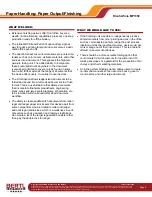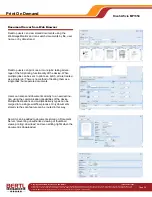
Copyright © 2006 MCA Internet, LLC dba BERTL.
13 November 2006
All Rights Reserved. The license under which this document is made available and applicable law prohibit any reproduction or further transmission of any portion of this document. This
document may only be viewed electronically through the www.BERTL.com Web site and may not be stored in electronic or hard copy format. Any reproduction of trademarks is strictly
prohibited. BERTL accepts no responsibility for any inaccuracies or omissions contained in this document.
Page 21
Ricoh Aficio MP1350
Market Background Information:
Copying is the standard feature on every
MFP on the market and is increasingly being
offered either as an option or a separate
model within network printer product ranges.
Before being wowed by headline speeds and
advanced features, consider that the most common copy
job is a single set of a simplex document that is five pages
or less with no finishing and no changes to image quality
default settings.
Small, Simple Jobs
Despite the wealth of features that MFPs offer today, most
users will not be prepared to wade through countless
screen menus to get to the point where they can press the
Start button. Think in terms of human productivity, not
device productivity. Reporting the productivity of the
device from the moment the green start button is pressed
until the final page comes out does not consider the most
costly element in the copying process: the user’s time.
Large, Complex Jobs
Even for big jobs—where you may think engine speed
plays a larger role—the simple start-key-to-finish-line
productivity measurement approach again disregards the
user. The user is less likely to wait at the copier for larger
and more complex jobs. They will look for features such
as a quick and easy job setup menu, fast scanning (so
they can return to their desk with the originals faster),
email notification when the job has finished (eliminating
the guesswork of when to return to the device to collect
the job), or the ability to build a job using a mix of pages
scanned from the document feeder and platen.
Features or Benefits?
Many copy features that are overlooked by the masses
are critical time savers in niche workflow environments.
For example, medical offices or car dealerships need to
copy insurance and license cards. A card copy feature
allows the user to scan the first side of the card, turn the
card over, scan the second page, and produce a single-
sided copy with both sides of the card on the single sheet.
This saves 50 percent on paper and the print click cost
charged by the dealer.
Copier Concurrency
Concurrency, the ability to handle multiple tasks at the
same time, varies greatly in workgroup devices. Some
devices cannot accept a copy job while a print or copy job
is in progress. If a connected MFP is carrying out either
job, a walk-up user must wait for it to finish before they
can scan in their copy.
My Copier
MFP design is moving away from proprietary, closed
systems, and is embracing open architecture and IT
standards like .NET and Java. This opens the door to
greater flexibility in the way the walk-up experience can be
tailored to each user. Coupled to this ability is the growing
need to account for all device usage for security,
compliance, or cost considerations. These two trends can
result in a “My Copier”-type experience where each user is
greeted with their favorite settings when logging in.
Maximum Copy Speed
135-ppm
First Copy Out Time
3.0 seconds
Document Feeder Type
Automatic Reversing Document
Feeder
Document Feeder Capacity
100 sheets
Job Build
Standard
Job Build Combining Platen and
Document Feeder Scans
Standard
Scan Ahead Copy Memories
20
No. of Copy Job Programs
25
Customizable One-touch
Buttons on Home Screen
Yes, 6
Max/Min Zoom Ratio
25% - 400%
Cover Insertion
Standard
Sheet Insertion
Standard
Page Stamp Options
Date, Time, Watermark, Set
Numbering, Overlay, Bates
Copy Features Summary
Copy
















































